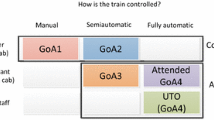Abstract
Although Dutch train operation is one of the safest in the European Union, safety remains one of the top priorities. On a yearly basis, an estimated 7 million red signal approaches occur on the Dutch railway network for the largest train operating company NS Reizigers. These red signals alert a driver to prepare to stop the train, possibly because the next section of the track is occupied by another train. Out of these 7 million red signal approaches, 3 million red signal approaches are estimated to be caused by small deviations from the planning. As a result of this continuous focus on safety aspects, ProRail, the Dutch rail infrastructure manager, and NSR started a project to empower train drivers with more information on the current situation and near future related to their trains. In a simulation study four train driving strategies were compared in two areas in the network. These strategies, ranked in order of increasing level of driver information quality, are: first is driving at highest allowed speed, second is following the timetable without advisory speed information, third is using advisory speed information without changing train orders, and fourth is using advisory speed information with the possibility of changing train orders. At each location the timetable has been exposed to three increasing levels of disturbance scenarios. Results show that the advisory speeds strategy (third) reaps a large part of the safety benefits that the fourth (limited Centrally Guided Train Operation) strategy is able to achieve.




Similar content being viewed by others
References
Al Ibrahim A (2010) Dynamic delay management at railways: a semi-Markovian decision approach, Thela Thesis, Amsterdam
Albrecht T, van Luipen J (2006) What role can a driver information system play in railway conflicts? 10th IFAC symposium control in transportation systems. Delft, The Netherlands
Albrecht T, Goverde RMP, Weeda VA, van Luipen J (2006) Reconstruction of train trajectories from track occupation data to determine the effects of a Driver Information System. In: Allan J, Brebbia CA, Rumsey AF, Sciutto G, Sone S, Goodman CJ (eds) Computers in Railways X. WIT Press, Southampton, pp 207–216
Corman F (2010) Real-time railway traffic management: dispatching in complex, large and busy railway networks, Ph.D. Thesis, TRAIL Thesis Series 2010/14
Corman F, D’Ariano A, Marra AD, Pacciarelli D, Samà M (2016) Integrating train scheduling and delay management in real-time railway traffic control. Transp Res Part E. doi:10.1016/j.tre.2016.04.007
D’Ariano A (2008) Improving real-time train dispatching: models, algorithms and applications, TRAIL Thesis Series T2008/6 1–240. TRAIL Research School, Delft
Dollevoet T, Corman F, D’Ariano A, Huisman D (2014) An iterative optimization framework for delay management and train scheduling. Flex Serv Manuf J 26(4):490–515
European Railway Agency (2013) Intermediate report on the development of railway safety in the European Union. http://www.era.europa.eu
Giannettoni M, Savio S (2004) The European Project COMBINE 2 to Improve Knowledge on Future Rail Traffic Management Systems. In: Allan J, Brebbia CA, Hill RJ, Sciutto G, Sone S (eds) Computers in railways IX. WIT Press, Southampton, pp 603–612
IEEE Std 1516™, IEEE Standard for Modeling and Simulation (M&S) High Level Architecture (HLA)
Kecman P, Corman F, D’Ariano A, Goverde RMP (2013) Rescheduling models for railway traffic management in large-scale networks. Public Transp Plan Oper 5(1–2):95–123
Mascis A, Pacciarelli D (2002) Job-shop with blocking and no-wait constraints. Eur J Oper Res 143:498–517
Mascis A, Pacciarelli D, Pranzo M (2002) Models and algorithms for traffic management of rail networks. Technical Report DIA-74-2002, Dipartimento di Informatica e Automazione, Universita Roma Tre
Mazzarello M, Ottaviani E (2007) A traffic management system for real-time traffic optimization in railways. Transp Res Part B 41(2):246–274
Middelkoop M, Mazzarello M, DeVries DK (2013) Optimizing train traffic: demonstrating benefits in a case study. In: 5th international conference on railway operations modelling and analysis
NS (2014) Annual report 2014. http://nsjaarverslag.nl
ON-TIME (2013) Task 6.1 Assessment of State-of-Art of Driver Advice Systems. http://www.ontime-project.eu
Rodriguez J (2012) Scheduling theory and constraint programming applied to rail traffic management, in Farewell address, Prof. Ingo Hansen, Delft University of Technology, pp 133–145
Sabbaghian, Mohammad (2014) A stable speed advice for reliable and safe rail traffic. MSc Thesis, University of Twente, retrieved from http://essay.utwente.nl/65114/1/Sabbaghian_MA_MB.pdf. Accessed July 2016
Scheepmaker GM (2013) Running time supplements in railway timetables: Energy efficient operation versus robustness, M.Sc. Thesis. Delft University of Technology
Scheepmaker GM, Goverde RMP (2015) Running time supplements: energy-efficient train control versus robust timetables. In: Paper presented at the 6th international conference on railway operations modelling and analysis
Szpigel B (1973) Optimal train scheduling on a single track railway. In: Ross M (ed) OR’72. North Holland, Amsterdam, pp 343–352
Author information
Authors and Affiliations
Corresponding author
Rights and permissions
About this article
Cite this article
Lentink, R.M., Middelkoop, D. & de Vries, D. A comparison of different configurations of a Centrally Guided Train Operation System in Dutch Railway Operations. Public Transp 9, 273–284 (2017). https://doi.org/10.1007/s12469-017-0156-0
Accepted:
Published:
Issue Date:
DOI: https://doi.org/10.1007/s12469-017-0156-0




